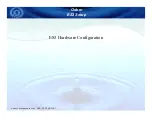
12
REF0315 March-2015
4
Maintenance
4.1
Maintenance planning
The OpeMax Lite is constructed in such a way that
maintenance can be kept to a minimum. It is
recommended that the following maintenance schedule
be adhered to:
Daily and Weekly maintenance that can be done by the
users of the OpeMax Lite.
The ½ Annual maintenance can be done by a
technical service. The Annual inspection and
possible repair of the OpeMax Lite by OpeMed or
another authorised body.
In case of doubt about the condition of the
hoist, always contact the TD or OpeMed.
4.1.1
Daily maintenance
The following operations can be carried out by hoist
users on a daily basis.
The hoist
•
Check the battery status. Charge when
needed.
The sling
•
Use a clean sling.
•
Always check that the sling and clips are in good
condition.
•
Check for the presence of ribs.
•
Hang up the sling after use and ventilate or
dry if necessary.
4.1.2
Weekly maintenance
The following operations can be carried out by hoist
users on a weekly basis.
The hoist
•
It is recommended to clean the hoist
weekly. It can best be cleaned with
household cleaner and a well squeezed
damp cloth.
•
Check the operation of the emergency
stop.
•
Check that all moving parts move
smoothly and without annoying noises.
•
Check the readability of the serial number
sticker and the presence of a manual,
quick reverence card and logbook.
•
Fully charging the battery (even when the
hoist is not used)
The slings
•
The slings can be washed at 60 degrees and
should not be tumble-dried or ironed.
•
Use the correct concentration for disinfection as
described on the packaging.
•
Check the sling for any damage to the sling or
clips, fabric fraying, loose stitching and seams.
If any of these damages are observed, do not
use the sling. Then contact the sling supplier.
4.1.3
½ Annual maintenance
The table below gives an overview of the maintenance
that the technical service can perform on the OpeMax
Lite every six months.
•
Thoroughly check the slings visually for fraying - loose
seams/stitches - damage to the sling, as well as the
sling clips; if they are damaged, the sling must be
rejected.
•
Check the operation of the emergency stop.
•
Check the emergency down operation.
•
Check the hoist thoroughly for smooth movement of
parts.
•
The hoist arm and leg spacer must run properly.
•
Check damage to plastic parts.
•
Check that the wheels rotate easily and that the brake
is working properly.
•
All bolts should be properly tightened and not loose.
•
Check the hoist for any deformations.
•
Check the hoist for excessive paint damage.
•
Check that the battery is properly charged and the
housing is in good condition.
•
Check the cabling for damage.
•
Also check the charger for function and for damage to
the cables.
If the hoist does not comply with one or more of the
above points, the hoist should be shut down and
OpeMed should be contacted.
4.1.4
Annual inspection and maintenance
Once a year, the hoist must be inspected according to
NEN. This must be done by OpeMed or by another
authorised body. OpeMed offers you the possibility to
have your hoist thoroughly inspected once a year, by
means of the Periodic Inspection Agreement. The next
inspection date is shown on the service control sticker
(figure 4). This is always on the hoist, near the serial
number plate. For more information about this, please
contact OpeMed by telephone.
The service control sticker (figure 5) indicates the date on
which the next Periodic Inspection must be carried out on
the OpeMax Lite.
Chargers must also be inspected each year in
accordance with the applicable regulations.
Figure 4
Содержание OpeMed OpeMax Lite
Страница 2: ......








































